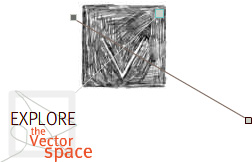Hypermedia Berlin
Cultural History in the Age of New Media, or "Is There a Text in this Class?"
Designer's Statement
http://www.berlin.ucla.edu/hypermedia (Use this link to open Hypermedia Berlin before launching the Flash 'walkthrough' to the right.)
UCLA's Center for Digital Humanities consults with faculty in the Humanities division who are working on projects that go beyond the capabilities of our course-management system. In addition to technical expertise, CDH provides the technical infrastructure that supports not just the faculty member, but the graduate students who participate in the project as well as the students who take the course.
CDH's technical team, led by Eugene Horikawa, decided that Flash would be the most suitable venue for developing the concept of interlinking time and space layers for "Hypermedia Berlin." Because the time-map applications that we first examined did not convey a sense of actually moving in time and space, we looked to other programs to convey mobility. We discovered a product called "Zoomifier" for Flash, which gives users both a global and local view of large-scale, highly detailed images by allowing them to zoom in and out. The program allowed us to modify the core functionality (via source code), giving us the ability to precisely control the interactivity of the navigation.
We are sometimes asked whether users could gain the same experience from Powerpoint presentations. We believe that the freedom to navigate in a non-linear fashion creates a uniquely "immersive experience" for the viewer moving through a new geographic space—similar to the way tourists "learn" or become acquainted with a new city. Rather than learning the material as linear "snapshots," Hypermedia Berlin foregrounds the "big picture" or the contextual relationships between the cultural artifacts that make up the site. By providing the context for each piece of content, we believe that users are more apt to engage in the interactive construction of a shared cognitive space.
Hypermedia Berlin is part of the "incubating" process at CDH. The next steps will be to scale up the project and connect the interface with a more robust and persistent digital repository, one that is maintained by UCLA's Digital Library Program. This will include developing ways for peer-reviewed scholarly contributions to be incorporated into the site, making it an arena for scholarly collaboration and contribution. Other projects at CDH have taken inspiration from the time-map interface, and we are confident that the technology we have developed for mapping Berlin will be put to good use in other upcoming projects examining the relationship between space, mobility, and culture.



